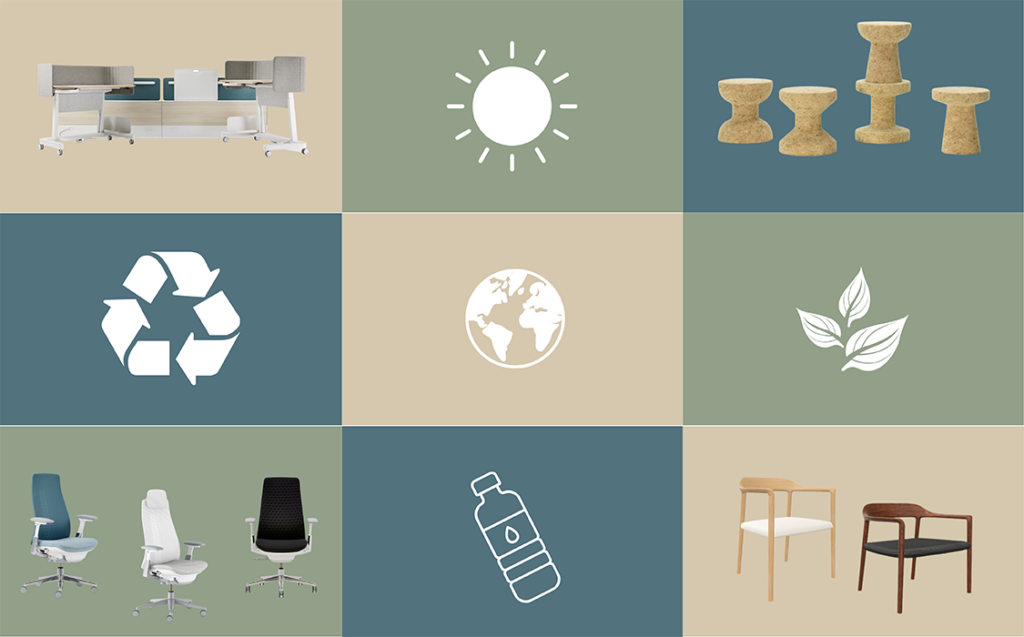Specifying Furniture for a Healthier Planet

Earth Day is an excellent reminder that we all have a responsibility for the health of our planet and the lives it supports. As developments in research and technology make it easier to specify products that contribute to a healthy environment, dealers like WB Wood, are prioritizing sustainability 365 days a year—partnering with manufacturers who share their values and amplify their efforts toward reducing our ecological footprint. This means specifying sustainable furniture.
Sustainability in design and manufacturing doesn’t just happen. It’s the result of identifying, adopting, and specifying in a way that ensures your project has the least possible impact on the environment. Whether you’re specifying for an office, or other commercial spaces, establishing sustainability standards for the products you specify is the first step in promoting environmental responsibility, improving wellness in the workplace, and fostering corporate sustainability initiatives.
Here’s a framework for ensuring your specifications are contributing to a greener workplace.
It starts with sourcing and selecting sustainable materials
Sourcing materials locally and choosing products made from eco-friendly materials contributes to a better planet. This matters even more in a global economy where supply chains are expanding into developing countries in search of lower costs and larger product capacity—often at significant cost to the environment in those nations. Specifying furniture for a green workplace starts with knowing what your furniture is made of and where it came from.
● Look for manufacturers that place a premium on responsibly sourced materials, like FSC-certified wood, recycled metals, and low-impact plastics. Andreu World, for example, uses 100% FSC certified wood from well managed forests in all their solid wood products. Their Liceo wood seating line is a great example of strong design backed by socially responsible material sourcing.
● Expand your use of eco-friendly renewable and rapidly renewable materials—bamboo, cork, or reclaimed wood—for example, to reduce reliance on nonrenewable resources. Iconic firm Vitra offers a table line that’s made entirely from cork. It’s functional, beautiful, and eminently sustainable furniture. And it’s just one of many sustainable products designed and produced under Vitra’s sustainability focus.
● And it should go without saying that it’s critical to avoid products that are manufactured with hazardous substances, such as formaldehyde-based adhesives, toxic finishes, and flame retardants in order to protect indoor air quality and human health.
Reducing Energy Use and Emissions
There are no two ways around it: Our fossil fuel consumption must be curtailed if we’re going to create a greener planet. Look for brands that are working to improve their energy efficiency and limit their emissions in the manufacturing processes.
● Specify from manufacturers that have invested in efficient processes and equipment. It’s one of the best ways to minimize energy consumption and greenhouse gas emissions.
● Follow the work of sustainability leaders like Haworth that are committed to achieving net zero emissions in their manufacturing process and have a defined plan to get there.
● Look for sustainable manufacturers like Tuohy that can add LEED credits to your project thanks to their eco-conscious manufacturing processes. The company’s wood casegoods, tables, and seating earn LEED credits for resource re-use, recycled content, use of rapidly renewing materials, use of certified materials, and for using materials extracted and manufactured in close proximity to their facilities.
Durability and Longevity
Studies show that far too often, buyers fail to consider the durability of a product in their specifications. Sometimes referred to as “product durability neglect,” research says that this tendency to overlook the long-term impact of a short-term product life leads to decisions that aren’t sustainable over time. Here’s how to avoid falling into the product durability neglect trap.
● Require durable construction techniques, high-quality materials, and robust designs to ensure the longevity of office furniture.
● Set minimum durability standards and warranty periods. Increasing demand for durable products has the side benefit of ultimately incentivizing manufacturers to produce longer-lasting products.
● Encourage the use of modular and adaptable furniture systems that can be easily reconfigured and upgraded to meet changing workplace needs, and that reduce the need for frequent replacements.
Circular Economy Standards
In our current “linear economy,” materials are extracted from the earth, turned into products, and then discarded as waste at the end of useful life. According to the United Nations Development Programme’s Climate Promise, only 7.2% of materials are cycled back into our economy after use. A circular economy, on the other hand, is a model of production and consumption that involves sharing, leasing, reusing, repairing, refurbishing, and recycling existing materials and products for as long as possible with the goal of waste reduction. Audit and assurance firm Deloitte points out that circular systems are different from “renewable” ones because they adhere to these three recognized principles: (1) Design out waste and pollution, (2) circulate products and materials in a way that preserves value, and (3) regenerate nature. Here’s how to ensure your specifications contribute to building a circular economy.
● Select manufacturers that use recycled materials in their production processes. As part of its sustainability focus, contract furniture manufacturer OFS, for example, offers amazing fabrics made from recycled bottles—one yard of their Allure fabric contains 31 recycled bottles. This kind of reuse closes the loop on material flow and reduces the use of nonrenewable resources. And they’re far from alone; about 90% of sustainability leader Emeco’s product line is made from recycled materials. Emeco sums up its sustainability story in a few words that are at the core of the circular economy: Begin with what’s left over. Turn it into what will last.
● Look for manufacturers that have a documented plan around circular design and circular economy principles—like zero waste, carbon neutral manufacturing. Companies like family-owned Stylex, for example, produce guides documenting their products’ End of Life Recovery Options to ensure that everything—from glides to arm caps to packaging foam—finds its way to a higher use. And sustainable manufacturers like Andreu World are spurring other manufacturers to step up their sustainability initiatives through their Circular Design Challenge.
● Choose products designed for reuse, remanufacturing, or recycling at the end of the product life. It should be easy to break down and recycle furniture when it’s seen better days. With end of life in mind, Haworth designed seating products like Zody II task chairs to meet the demands of a circular environment, including using clear recycling symbols, designed into the product components, to make it easier to recycle and more likely the components will be recycled after its useful life.
Indoor Environmental Quality Standards
Protecting indoor air quality can reduce absences and work hours by those affected by asthma, respiratory allergies, depression, stress, and more. According to the U.S. Environmental Protection Agency, people in the U.S. spend about 90% of their time indoors. That makes it critical to ensure that specification standards ensure a healthful space within the built environment.
● Choose low-emission materials and finishes to minimize volatile organic compound (VOC) emissions and improve indoor air quality. VOCs in the workplace can adversely affect employee well-being, both short- and long-term, according to US Environmental Protection Agency findings.
● Look for GREENGUARD Certification to ensure the products you specify are free of volatile organic compounds (VOCs) that lead to short-term discomfort and long-term chronic disease.
● If you’re specifying for a school, childcare, healthcare or similar environment, look for GREENGUARD Gold Certification, which lowers allowable VOCs even further. It’s a big deal to achieve gold in the race toward zero emissions. Check out Gold-certified mobile workstations like Compose Echo and seating options like the Fern Collection, for example, that offer the highest levels of protection for indoor air quality. Or Enwork tables, storage, and workstations that are designed to meet or exceed the standards of LEED, Healthier Hospitals Initiative, and Indoor Advantage Gold Certification.
Social Responsibility and Ethical Practices
It’s never been more important to be a good corporate citizen. Respecting the dignity of workers, creating a sense of belonging, and supporting the local economy are all key parts of a company’s Environmental Social Governmental (ESG) profile. Be sure your suppliers are good neighbors and good citizens by adopting these standards.
● Choose suppliers that honor fair labor practices, including fair wages, safe working conditions, and respect for workers’ rights throughout the supply chain.
● Choose suppliers that value diversity, equity, and inclusion in the workforce and supply chain as a means of promoting social equity and community engagement. Creating a welcoming, inclusive work environment starts with intentional design, culture, leadership, and policies, manufacturer Haworth stresses in their DEI in the workplace conversation.
● Choose suppliers who focus on local ethical sourcing and production to minimize transportation emissions and contribute to local economic development. Check into contract furniture manufacturers like Landscape Forms that source 60% of their materials within 60 miles of their facilities. They’re supporting their local economy and reducing their carbon footprint at the same time.
Pay Attention to Certifications and Labels
Anyone can say they’re green, but certification standards are the best way to ensure that the products and materials you’re considering are manufactured in a sustainable way. Consider these standards that help ensure your products are bonafide green.
● Seek out and prioritize third-party certifications, such as BIFMA level, LEED, GREENGUARD, or Cradle to Cradle, as indicators of compliance with green building practices and sustainability standards.
● Favor manufacturers that are transparent in disclosing their environmental and social performance metrics, so you can be sure you’re making informed purchasing decisions. This is becoming easier as more companies are expanding the nature and extent of their ESG reporting, according to tech company PwC.
By implementing comprehensive sustainability standards for office furniture, businesses can minimize their environmental footprint, enhance workplace wellness, and demonstrate their commitment to corporate sustainability and social responsibility. These standards not only benefit the environment but also contribute to long-term business resilience and competitiveness in a rapidly evolving market, and, according to research shared by Deloitte Insights, offer hidden potential for creating business value.
WB Wood places a priority on working with like-minded partners who share our commitment to sustainability as a core value. If you’re looking for support in sustainable specification, please contact us. We’re invested in creating better workspaces and a better world.
